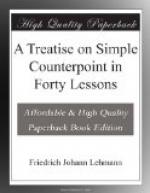[Illustration: Fig. 5.]
SIMPLE COUNTERPOINT IN TWO PARTS
FIRST SPECIES
Two-part counterpoint comprises a cantus firmus and a counterpoint. [Fig. 6.]
[Illustration: Fig. 6.]
Although in two-part counterpoint we have to deal with intervals, rather than harmonies, still the harmonic progressions represented by these intervals should be regarded.
The exercises should begin and close with tonic harmony. At the beginning the unison, fifth or octave, and at the close the unison or octave, are permitted. [Fig. 7.]
[Illustration: Fig. 7.]
After the first measure it is better to use imperfect consonances only. The perfect consonances, however, may be used sparingly when a more melodious counterpoint is thereby obtained.
The unison may be used in the first and last measures only. [Fig. 7.]
All progressions must be diatonic, and parts should not cross.
The repetition of a note in a lower part should be avoided wherever possible. In a higher part, repetition to the extent of three notes in succession is allowed.
Do not use more than three thirds or sixths in succession. [Fig. 8.]
[Illustration: Fig. 8.]
Successive similar skips, except the minor third (a), in one direction, are to be avoided. Successive skips of a fourth are good when the tones are the fifths of the triads on I, IV and vii deg.. The last tone should return one degree (b). [Fig. 9.]
Do not move more than an octave in one direction in two skips. [Fig. 9_c_.]
[Illustration: Fig. 9.]
Covered fifths and octaves, except from I to V, or V to I, are forbidden. [Fig. 10.]
[Illustration: Fig. 10.]
Both parts skipping in contrary motion to a fifth or octave should be avoided in two-part writing. [Fig. 11.]
[Illustration: Fig. 11.]
Avoid consecutive perfect intervals. [Fig. 12.]
[Illustration: Fig. 12.]
The augmented fourth (Tritone) is not only considered bad as a melodic interval by some authorities, but its appearance between different parts in successive intervals is also prohibited. This prohibition, however, holds good only when the chords in which it appears are in fundamental position, as in Fig. 13_a_. This is shown by the fact, that if one part skips as at b, there is no unpleasant effect.
[Illustration: Fig. 13.]
Avoid consecutive major thirds in major keys. In minor keys they are good. [Fig. 14.]
[Illustration: Fig. 14.]
Use adjacent voices in writing, and do not exceed the vocal compass of a voice.
Modulation may be resorted to within the exercises, but only to nearly related keys; for example, in C, to G, F, a, e, or d.
At the close parts should proceed stepwise to the unison, or octave. [Fig. 15_a_.]




